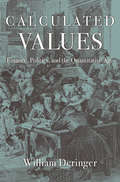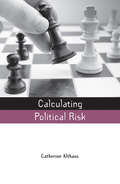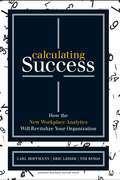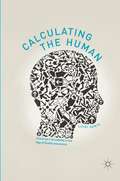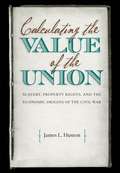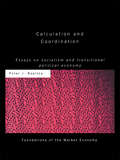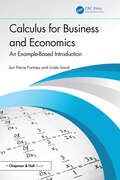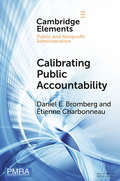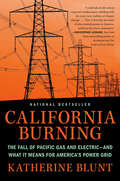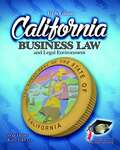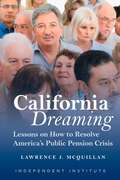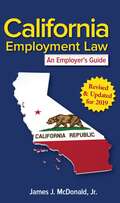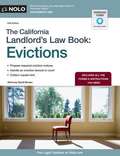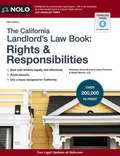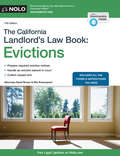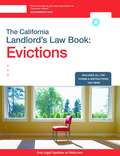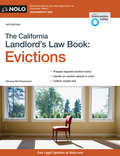- Table View
- List View
Calcined Clays for Sustainable Concrete: Proceedings of the International Conference on Calcined Clays for Sustainable Concrete 2022 (RILEM Bookseries #57)
by Ashirbad SatapathyThis book focuses on low-carbon sustainable cement production, performance, environmental efficiency, and other topics linked to calcined clays for sustainable concrete. It comprises select proceedings of the International Conference on Calcined Clays for Sustainable Concrete 2022, which was held at École Polytechnique Fédérale de Lausanne (EPFL)—Switzerland. The contents of this book focus on the influence of processing and clay mineralogy on the reactivity and rheology of calcined clay systems, Portland-calcined clay-limestone systems: hydration, durability, and performance, and calcined clay-alkali systems: hydration, durability, and performance, etc. This book can serve as a useful reference to researchers, academicians, and practitioners alike.
Calculated Values: Finance, Politics, and the Quantitative Age
by William DeringerModern political culture features a deep-seated faith in the power of numbers. But quantitative evidence has not always been revered, as William Deringer shows. After the 1688 Revolution, as Britons learned to fight by the numbers, their enthusiasm for figures arose not from efforts to find objective truths but from the turmoil of politics itself.
Calculating Free Cash Flows
by David S. Scharfstein Robin GreenwoodOutlines the mechanics of calculating free cash flows from historical and proforma financial statements. Focuses on the mechanical process of transforming numbers from financial forecasts into cash flows.
Calculating Political Risk (Earthscan Risk in Society)
by Catherine AlthausCalculating Political Risk is rich and illuminating, and much more than a political science treatise. Althaus draws on diverse literature, extensive interviews and intriguing case studies to offer interdisciplinary, practical and nuanced insight. This book provides new perspectives and more precise language for making sense of a critical dimension of politics, policy-making and public management. Evert Lindquist, Director and Professor, School of Public Administration, University of Victoria, Canada This powerful new book is the first ever examination of the hard edge of how political risk - something faced by all political actors innumerable times every day - is calculated and used in decision-making. It opens with an outline of the historical and linguistic origins of risk, the various disciplinary understandings of risk, the risk society concept, and how risk has come to be so prominent in the context of environmental disaster and terrorism. The book then defines political risk and looks at its manifestations in the public sector, from project to high-level political risk. It also looks at risk identification versus risk management and compares the concept of political risk with the private sector practice of risk management. Unique research findings from interviews with over 100 risk practitioners and politicians provide a detailed look at how political actors calculate political risk. Case study-based chapters look in-depth at neat and discrete examples: risk calculation in state development plans in Australia; political risk identification and management in the UK during the mad cow crisis; and US government risk calculation in the post-September 11 context. The final chapters draw together the experiences and lessons learned from the case studies and practitioner insights to formulate a better understanding of what political risk is and what its calculation means in political practice. The author shows how political risk calculation provides a fresh perspective on policy analysis and identifies how political risk is relevant to a broader understanding of politics and political science, as well as policy formulation and implementation on the ground.
Calculating Success
by Carl Hoffmann Tim Ringo Eric LesserCreate an Organization That Runs on More than Intuition and GuessworkMost companies today have access to reams of data: marketing, supply chain, finance, as well as critical data about their workforce. Yet research shows that leaders at these companies lack the confidence to effectively integrate and use this data to compete more effectively in the marketplace. While executives know the results they need to achieve, they often fail to analyze the impact of their decisions on the firm, its processes, and its people.Enter Calculating Success, written by a trio of experts who have spent decades working with companies to more effectively apply human capital data to improve organizational outcomes. Calculating Success shows readers how they can take an analytical approach to both anticipate and address the changes required by a company's competitive environment, and drive superior performance.Using an innovative six-step framework and introducing new tools, the authors show executives how to make smarter strategic decisions by evaluating the data at their fingertips.The framework will help leaders: Analyze the work that needs to be done and know how to structure it Provide the right types of people to do it Motivate them to engage in that work Explore innovative ways to get the work doneFull of detailed examples and case studies, Calculating Success will help you rethink the relationship of talent to business success. The result? A more motivated and cost-efficient workforce and a sustainable, systematic approach to acquiring talent and innovating how work gets done.
Calculating Sustainable Non-mineral Balances as Benchmarks for Fiscal Policy: The Case of Botswana
by Jens R. ClausenA report from the International Monetary Fund.
Calculating the Human
by Luigi DoriaWhy does contemporary calculation develop as calculation of the quality of everything? How should we consider calculation of quality and the relationship between calculation and enhancement of life? These and related questions are addressed through phenomenological investigation and a critical analysis of the social science debate.
Calculating the Value of the Union
by James L. HustonWhile slavery is often at the heart of debates over the causes of the Civil War, historians are not agreed on precisely what aspect of slavery--with its various social, economic, political, cultural, and moral ramifications--gave rise to the sectional rift. In Calculating the Value of the Union, James Huston integrates economic, social, and political history to argue that the issue of property rights as it pertained to slavery was at the center of the Civil War.In the early years of the nineteenth century, southern slaveholders sought a national definition of property rights that would recognize and protect their ownership of slaves. Northern interests, on the other hand, opposed any national interpretation of property rights because of the threat slavery posed to the northern free labor market, particularly if allowed to spread to western territories. This impasse sparked a process of political realignment that culminated in the creation of the Republican Party, ultimately leading to the secession crisis.Deeply researched and carefully written, this study rebuts recent trends in antebellum historiography and persuasively argues for a fundamentally economic interpretation of the slavery issue and the coming of the Civil War.
Calculation and Coordination: Essays on Socialism and Transitional Political Economy (Foundations Of The Market Economy Ser.)
by Peter J BoettkeThis collection of essays from one of the major Austrian economists working in the world today brings together in one place some of his key writings on a variety of economic issues.
Calculus for Business and Economics: An Example-Based Introduction
by Jon Pierre Fortney Linda SmailCalculus for Business and Economics: An Example-Based Introduction is designed for first-year university students specializing in business and economics. This book is crafted in a clear, easy-to-read style, covering all the essential calculus-related topics that students are likely to encounter in their studies. With real-world business and economics applications seamlessly integrated around the core calculus concepts, students will find the book of real practical value throughout their time in university and beyond. Features Three hundred easy-to-follow examples throughout, carefully crafted to illustrate the concepts and ideas discussed. Numerous exercises to practice, with solutions available online to help you learn at your own pace. Each chapter concludes with a section showcasing the real-world business and economics applications of the discussed mathematical concepts.
Calculus for Business, Economics, Life Sciences, and Social Sciences, Brief Version
by Raymond Barnett Michael Ziegler Karl Byleen Christopher StockerHelps students “get the idea.” Calculus for Business, Economics, Life Sciences, and Social Sciences, Brief Version, 14th Edition offers more built-in guidance than any other text in its field ― with special emphasis on applications and prerequisite skills ― and a host of student-friendly features to help students catch up or learn on their own. The text’s emphasis on helping students “get the idea” is enhanced in the new edition by a design refresh, updated data and applications, and a robust MyLab™ Math course.
Calgene, Inc.
by John T. Gourville Ray A. GoldbergIn 1993, Calgene is on the verge of introducing the world's first genetically engineered plant product--a tomato will taste better and stay fresh longer. At the same time, it is using biotechnology to produce improved plant products for the cottonseed and the industrial and edible oil markets. As it develops and brings these products to market, however, it faces a series of marketing and public relations hurdles, including regulatory requirements consumer education activist resistance to production, and distribution logistics. How Calgene reacts to these challenges may determine whether it succeeds or fails in its quest to revolutionize the business of agriculture. A rewritten version of an earlier case.
Calibrating Public Accountability: The Fragile Relationship between Police Departments and Civilians in an Age of Video Surveillance (Elements in Public and Nonprofit Administration)
by Étienne Charbonneau Daniel E. BrombergAccountability is a staple of Public Administration scholarship, but scholars have been unsuccessful at developing a predictive model of accountable behavior. Large swaths of research about accountability still focuses on scarcely read annual reports as video footage of police encounters are watched and discussed by citizens regularly. In this Element, we seek to further a predictive model of accountability by understanding the norms and expectations associated with the implementation of Body-Worn Cameras. Specifically, this research examines when police departments release, or do not release, footage to the public and the expectations civilians have about the release of that footage. Indirectly, the norms and expectations associated with this technology have broad implications for societal values and the relationship between civilians and law enforcement. Our findings suggest the relationship between law enforcement and civilians is central to the implementation of this policy, and more broadly, accountability.
California Burning: The Fall of Pacific Gas and Electric--and What It Means for America's Power Grid
by Katherine BluntA revelatory, urgent narrative with national implications, exploring the decline of California&’s largest utility company that led to countless wildfires — including the one that destroyed the town of Paradise — and the human cost of infrastructure failurePacific Gas and Electric was a legacy company built by innovators and visionaries, establishing California as a desirable home and economic powerhouse. In California Burning, Wall Street Journal reporter and Pulitzer finalist Katherine Blunt examines how that legacy fell apart—unraveling a long history of deadly failures in which Pacific Gas and Electric endangered millions of Northern Californians, through criminal neglect of its infrastructure. As PG&E prioritized profits and politics, power lines went unchecked—until a rusted hook purchased for 56 cents in 1921 split in two, sparking the deadliest wildfire in California history.Beginning with PG&E&’s public reckoning after the Paradise fire, Blunt chronicles the evolution of PG&E&’s shareholder base, from innovators who built some of California's first long-distance power lines to aggressive investors keen on reaping dividends. Following key players through pivotal decisions and legal battles, California Burning reveals the forces that shaped the plight of PG&E: deregulation and market-gaming led by Enron Corp., an unyielding push for renewable energy, and a swift increase in wildfire risk throughout the West, while regulators and lawmakers pushed their own agendas.California Burning is a deeply reported, character-driven narrative, the story of a disaster expanding into a much bigger exploration of accountability. It&’s an American tragedy that serves as a cautionary tale for utilities across the nation—especially as climate change makes aging infrastructure more vulnerable, with potentially fatal consequences.
California Business: Law and Legal Environment
by Kim Tyler Walter Roy Huber William McGrathPublished in 2018, this newest edition of California Business Law has undergone major C-ID renovations, including the title. It is now the 5th edition of California Business Law (Legal Environment of Business). <p><p>There is a reason for this change, that includes among other things a mandate from the Community College Chancellor’s Office (Senate) regulating the material necessary to include in a Business Law or Legal Environment of Business book in order to qualify it for transfer to the Cal-State or UC System. They have adopted a “universal” C-ID numbering system of 120 (Business Law) and 125 (Legal Environment). Although not all community colleges use this numbering system, they are required to adhere to the topics enumerated in the list.
California Dreaming: Lessons on How to Resolve America's Public Pension Crisis
by Lawrence J. McQuillanA politically created crisis of epic proportions is brewing in California and elsewhere across the United States.For decades, public pension officials and politicians of both parties have promised their employees increasingly generous retirement benefits—while low-balling the contributions from government agencies and employees that are needed to cover these promises—presenting our greatest financial challenge since the Great Depression. Pushing the pension liability from today and onto our children and grandchildren leaves them with a depleted future and a potentially bankrupt California. State and local governments will scramble to find funds, forcing them to raise taxes, slash public services, and/or declare bankruptcy. Schools, parks, emergency services, and public-employee retirement benefits will be at risk. Politicians will defer until circumstances force them to reckon with a disaster of their own making. The problem? For far too long, state and local governments have promised their employees increasingly generous retirement benefits—but without ensuring that sufficient funds will be on hand when the pension payments come due. In California Dreaming, Lawrence J. McQuillan pulls back the curtains covering this unfunded liability crisis. He describes the true extent of the problem, explains the critical factors that are driving public pension debt sky-high, and exposes the perverse incentives of lawmakers and pension officials that reward them for not fixing the problem and letting it escalate. Finally, he offers the six crucial reforms needed to restore the financial health of California and other threatened jurisdictions. If California Dreaming&’s roadmap for reform is adopted, the prospects for achieving a thriving, balanced and equitable future are highly favorable in California and any state or municipality facing its own public pension problem. If not, the many opportunities that once made the Golden State seem like a Promised Land will quickly evaporate.
California Employment Law: An Employer's Guide
by James McDonaldWritten especially for HR professionals and business people, California Employment Law: An Employer's Guide is the essential resource for avoiding the many perils and pitfalls California employers face. Comprehensively updated to address new developments, the 2019 Edition features: New independent contractor test New harassment training requirements Class-action waivers in arbitration agreements New rules on national origin discrimination Requirement that employees be paid for minimal preparation and concluding work Clarification of rules regarding salary history inquiries New NLRB standards for employee conduct policies Requirements for lawful time clock rounding Rules for rest break pay for commissioned and piece-rate employees ?New rules regarding lactation breaks
California Greenin': How the Golden State Became an Environmental Leader (Princeton Studies in American Politics: Historical, International, and Comparative Perspectives #157)
by David VogelA political history of environmental policy and regulation in California, from the Gold Rush to the presentOver the course of its 150-year history, California has successfully protected its scenic wilderness areas, restricted coastal oil drilling, regulated automobile emissions, preserved coastal access, improved energy efficiency, and, most recently, addressed global climate change. How has this state, more than any other, enacted so many innovative and stringent environmental regulations over such a long period of time? The first comprehensive look at California's history of environmental leadership, California Greenin' shows why the Golden State has been at the forefront in setting new environmental standards, often leading the rest of the nation.From the establishment of Yosemite, America's first protected wilderness, and the prohibition of dumping gold-mining debris in the nineteenth century to sweeping climate- change legislation in the twenty-first, David Vogel traces California's remarkable environmental policy trajectory. He explains that this pathbreaking role developed because California had more to lose from environmental deterioration and more to gain from preserving its stunning natural geography. As a result, citizens and civic groups effectively mobilized to protect and restore their state's natural beauty and, importantly, were often backed both by business interests and bystrong regulatory authorities. Business support for environmental regulation in California reveals that strict standards are not only compatible with economic growth but can also contribute to it. Vogel also examines areas where California has fallen short, particularly in water management and the state's dependence on automobile transportation. As environmental policy debates continue to grow more heated, California Greenin' demonstrates that the Golden State's impressive record of environmental accomplishments holds lessons not just for the country but for the world.
California Landlord's Law Book, The
by David BrownReady to evict a problem tenant? Use the definitive step-by-step guide to evictions in California Sooner or later, every landlord is faced with handling an eviction. Don't get caught spending thousands on attorney's fees when The California Landlord's Law Book: Evictions will guide you through the process every step of the way -- without breaking the bank. Read up on the different legal grounds for eviction in plain English, plus get all the forms and step-by-step instructions needed to perform a successful and legal eviction. Learn how to: -prepare and serve 3-, 30-, 60- or 90-day notices -file an unlawful detainer complaint in court -win by default if the tenant doesn't respond -handle a contested case -represent yourself in court -deal with eviction-delaying tactics -collect the unpaid rent after you win Still the only step-by-step guide through the California eviction process, the 14th edition reflects current law and provides the latest information, forms, and instructions for a quick and legal eviction. Nolo has dozens of products created just for California residents. Check out Nolo's list of California products.
California Landlord's Law Book, The
by David BrownEvery California landlord and residential property manager needs The California Landlord's Law Book: Rights & Responsibilities. For over 20 years, the definitive guide for landlords in the Golden State has clearly and comprehensively covered everything you need to know about: -security deposits -leases and rental agreements -inspections -habitability -liability -lead paint -discrimination -rent control -satellite dishes -...and much more This edition includes fully up-to-date landlord-tenant laws and legal forms, including new details on how to terminate a lease when you become the owner or a foreclosed-upon home, and a plain English explanation of the new utility shutoff law. Plus, you'll get over 25 legal forms and agreements, including rental applications; leases and rental agreements; 3-, 30-, 60- and 90-day eviction notices -- and much more. Not a California landlord? Check out Every Landlord's Legal Guide.
California Landlord's Law Book, The: Evictions
by David Brown Nils RosenquestReady to evict a problem tenant? Use the definitive step-by-step guide to evictions in California. Sooner or later, every landlord is faced with handling an eviction. Don't get caught spending thousands on attorneys fees when The California Landlord's Law Book: Evictions will guide you through the process every step of the way -- without breaking the bank. Read up on the different legal grounds for eviction in plain English, plus get all the forms and step-by-step instructions needed to perform a successful and legal eviction. Learn how to: prepare and serve nonpayment of rent notices prepare and serve 30-, 60- or 90- day notices file an unlawful detainer complaint in court win by default if the tenant doesn't respond handle a contested case represent yourself in court deal with eviction-delaying tactics, and collect the unpaid rent after you win. Still the only step-by-step guide through the California eviction process, this edition reflects current law and provides the latest information, forms, and instructions for a quick and legal eviction.
California Landlord's Law Book, The: Evictions
by David Brown AttorneyReady to evict a problem tenant? Use the definitive step-by-step guide to evictions in California Sooner or later, every landlord is faced with handling an eviction. Don't get caught spending thousands on attorney's fees when The California Landlord's Law Book: Evictions will guide you through the process every step of the way -- without breaking the bank. Read up on the different legal grounds for eviction in plain English, plus get all the forms and step-by-step instructions needed to perform a successful and legal eviction. Learn how to: prepare and serve 3-, 30-, 60- or 90-day notices file an unlawful detainer complaint in court win by default if the tenant doesn't respond handle a contested case represent yourself in court deal with eviction-delaying tactics collect the unpaid rent after you win Still the only step-by-step guide through the California eviction process, this edition reflects current law and provides the latest information, forms, and instructions for a quick and legal eviction. Check out Nolo's list of California products.
California Landlord's Law Book, The: Evictions
by Nils RosenquestYour step-by-step guide to evicting a problem tenant in California Sooner or later, nearly every residential landlord has to evict a tenant for nonpayment of rent, property damage, an illegal sublet (including Airbnb), or another violation of the lease or the law. You don’t always need to hire a lawyer, but you do need reliable information, particularly if your property is under rent control. Here, you’ll find all of the forms you need along with clear, step-by-step instructions on how to: prepare nonpayment of rent notices prepare 3-, 30-, 60-, and 90-day notices complete and serve all required eviction forms deal with tenants’ delaying tactics, and file your “unlawful detainer” complaint in court. Just filing an eviction lawsuit may prompt the tenant to leave. If it doesn’t, you’ll learn how to: handle a contested eviction suit by yourself—and know when to get professional help respond to a tenant’s defenses and claims evict a tenant who has filed for bankruptcy or is occupying property you purchased at a foreclosure sale, and collect unpaid rent after you win. All forms are downloadable through a special link in the book.

